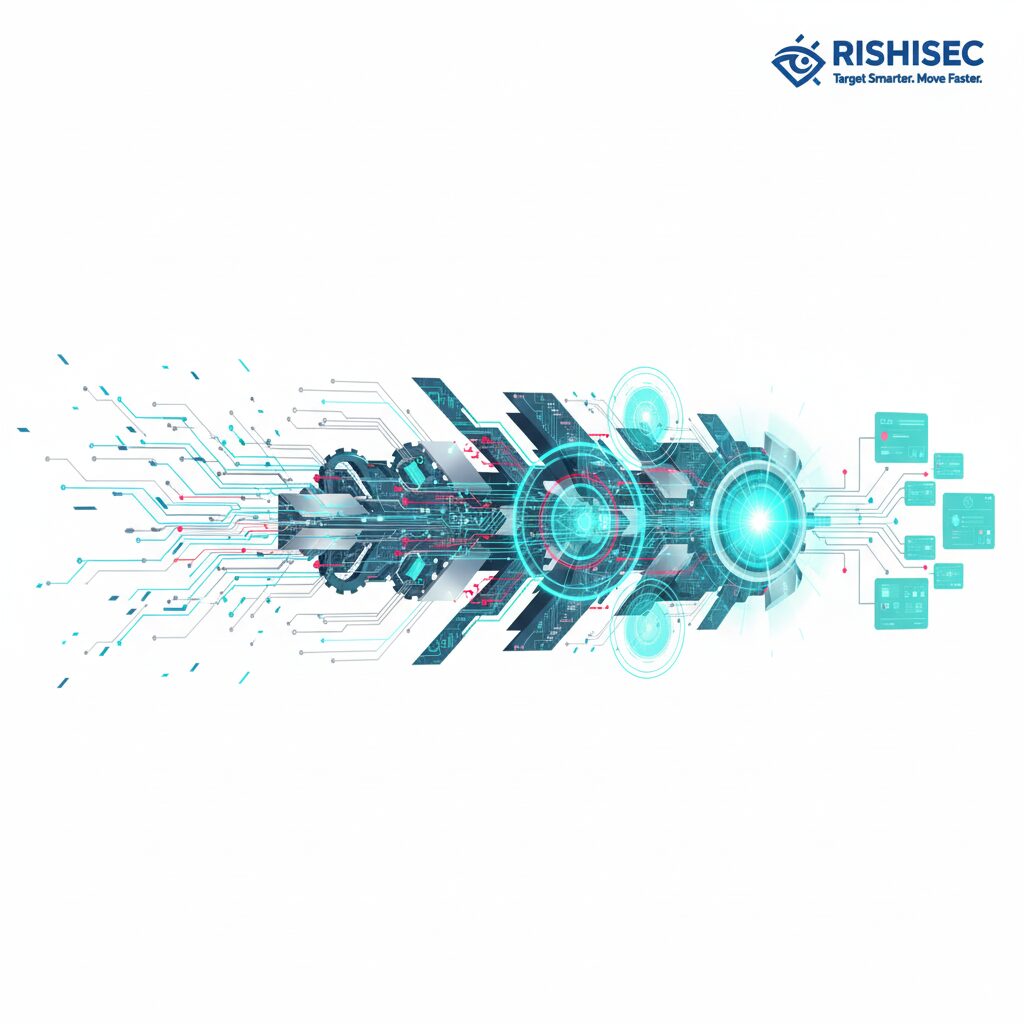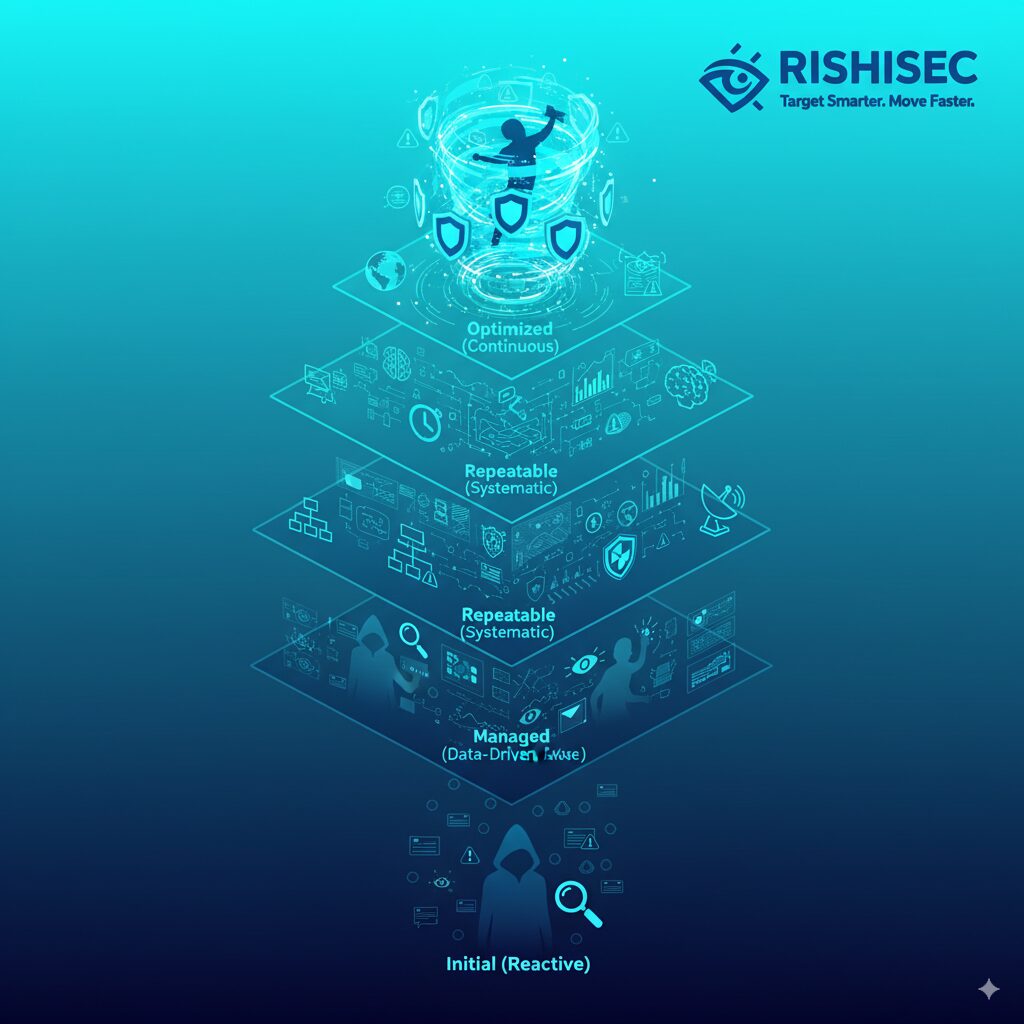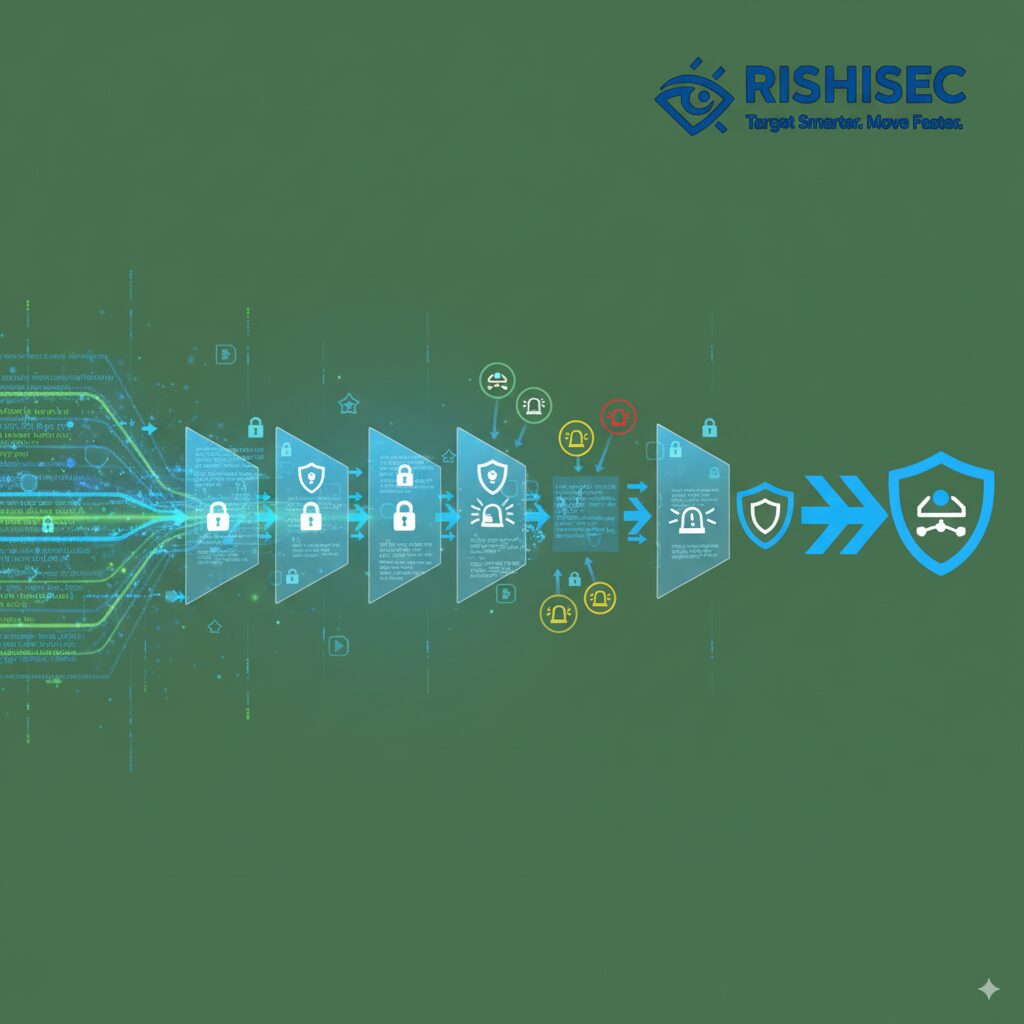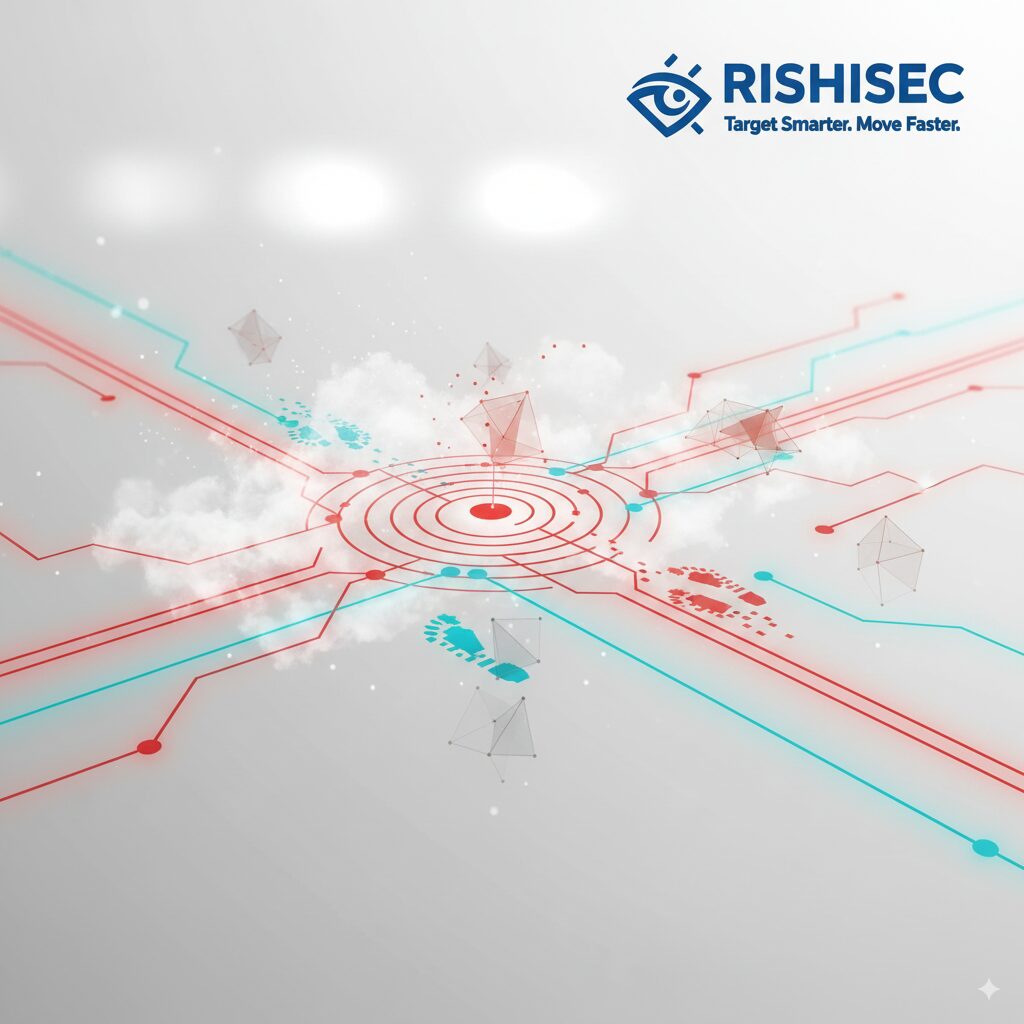Cybersecurity consultants waste countless hours on reconnaissance that automation could handle in minutes. Yet, many penetration testers still manually query dozens of intelligence sources, copy-paste findings into spreadsheets, and struggle to maintain consistent documentation across engagements. Penetration testing OSINT workflow optimization is not about working harder; it is about systematically eliminating inefficiencies that drain billable hours and compromise assessment quality.
Modern penetration testing demands speed without sacrificing thoroughness. Clients expect comprehensive assessments delivered within tight timelines, often just days or weeks. Meanwhile, attack surfaces continue expanding as organizations adopt cloud infrastructure, microservices, and distributed systems. Traditional manual reconnaissance simply cannot keep pace with these demands, making workflow optimization a competitive necessity for security consultants.
Why Most Penetration Testing OSINT Workflows Fail
The typical penetration testing OSINT workflow suffers from fundamental inefficiencies that compound across every engagement. Testers begin with a target domain and start manually checking common intelligence sources: WHOIS lookups, DNS enumeration, subdomain discovery, and employee social media reconnaissance. Each source requires different tools, different syntax, and different output formats. By the end, testers have scattered data across terminal windows, text files, and browser tabs with no systematic way to correlate findings.
Documentation gaps create the second major failure point. During active reconnaissance, testers discover interesting findings but fail to document the collection methodology. Weeks later when writing the final report, they cannot remember which tool produced which result or how to reproduce their discoveries. This forces redundant work and creates quality issues when clients question findings.
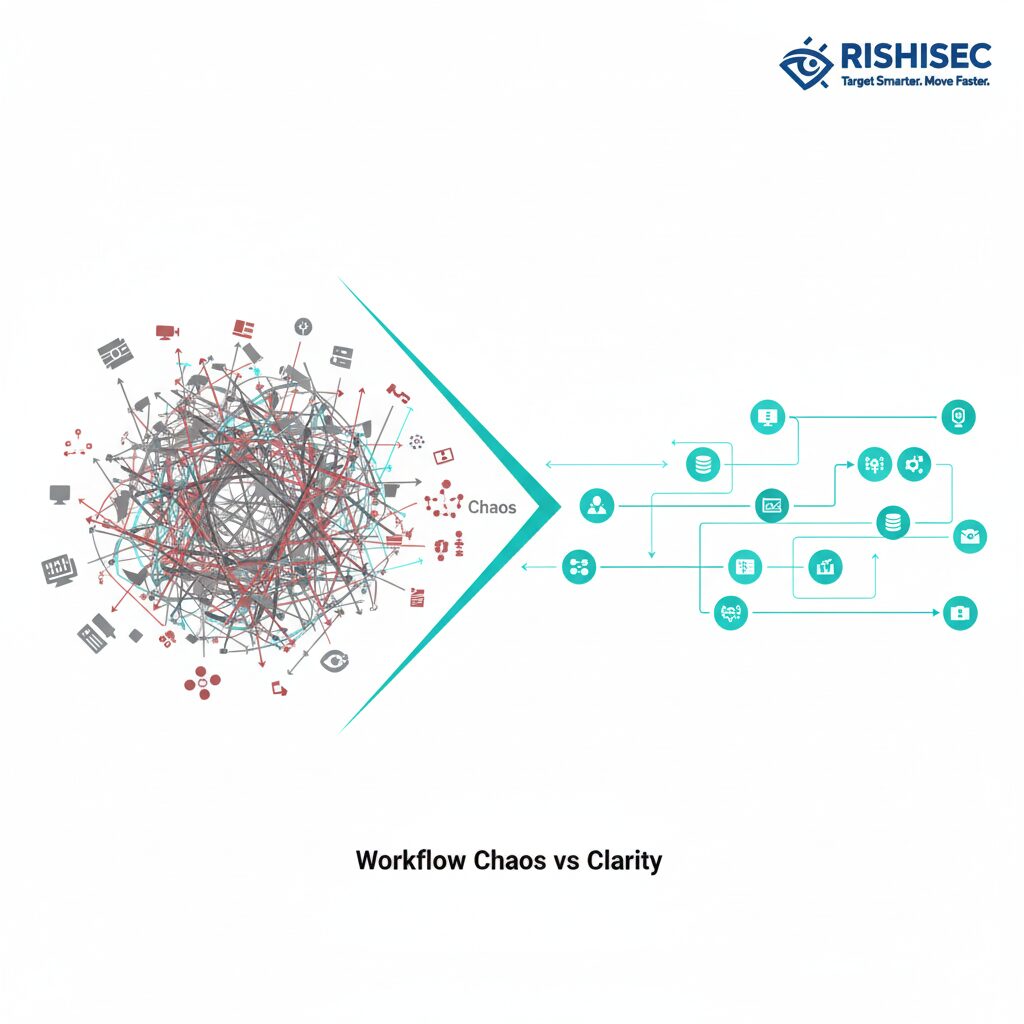
Tool sprawl represents another critical inefficiency. Security consultants accumulate dozens of specialized reconnaissance tools over their careers, each solving one narrow problem. Running separate tools for subdomain enumeration, certificate transparency searches, social media scraping, and cloud storage discovery creates context-switching overhead. Testers constantly jump between interfaces, each with unique command syntax and output formats that resist integration.
Perhaps most importantly, manual workflows prevent knowledge transfer across engagements. When reconnaissance techniques live only in individual testers’ heads, organizations cannot standardize processes, train new consultants efficiently, or maintain quality consistency. Each penetration tester develops personal workflows optimized for their preferences rather than organizational efficiency.
Building Your Core OSINT Intelligence Collection Framework
Effective penetration testing OSINT workflow optimization starts with standardized intelligence collection frameworks. Rather than ad-hoc reconnaissance, create structured methodologies that ensure comprehensive coverage while eliminating redundant work. Your framework should define what intelligence to collect, which sources to query, and how to organize findings for later analysis.
Begin by categorizing intelligence into operational domains: network infrastructure, personnel, technology stack, and security posture. Network infrastructure intelligence includes domains, subdomains, IP ranges, hosting providers, and CDN configurations. Personnel intelligence covers employee names, roles, social media profiles, and contact information. Technology stack intelligence identifies software versions, frameworks, development tools, and third-party services. Security posture intelligence reveals defensive capabilities, monitoring tools, and incident response preparedness.
| Intelligence Domain | Key Data Points | Primary Sources |
|---|---|---|
| Network Infrastructure | Domains, subdomains, IP ranges, hosting providers, SSL certificates | DNS records, certificate transparency, ASN lookups, reverse IP searches |
| Personnel | Employee names, roles, contact info, organizational structure | LinkedIn, corporate websites, conference presentations, email patterns |
| Technology Stack | Software versions, frameworks, development tools, cloud platforms | Job postings, GitHub repositories, technical blogs, error messages |
| Security Posture | Security tools, monitoring capabilities, incident response readiness | Job descriptions, vendor partnerships, security certifications, past breaches |
Next, map intelligence sources to collection methods. Some sources permit API access that enables automated querying. Others require web scraping that demands careful rate limiting and user-agent rotation. Still others need manual review because they contain context that automation misses. Understanding which collection methods work best for each source prevents wasted effort on overly complex automation.
Your framework must also address intelligence freshness. Network infrastructure changes frequently as organizations deploy new systems and decommission old ones. Personnel information becomes stale as employees change roles or leave. Technology stacks evolve through software updates and migration projects. Effective workflows incorporate refresh cycles that re-collect time-sensitive intelligence while caching stable findings to avoid redundant queries.
Automation Strategies That Actually Work in Production
Penetration testing automation requires balancing thoroughness with speed and reliability. Over-automation creates brittle systems that break when websites change layouts or APIs modify response formats. Under-automation leaves testers drowning in manual work. The optimal automation strategy targets high-value, repetitive tasks while preserving human judgment where it matters most.
Start automating with low-hanging fruit: tasks that are perfectly defined, rarely change, and consume significant time. Subdomain enumeration fits this profile perfectly. Multiple reliable tools and data sources exist, the process follows clear logic, and manually querying dozens of sources wastes hours. Create automation that queries all relevant sources in parallel, deduplicates results, and outputs clean lists ready for the next testing phase.
API-based intelligence collection offers the most reliable automation opportunities. Services like certificate transparency logs, DNS databases, and cloud storage enumeration provide structured APIs designed for automated queries. Unlike web scraping that breaks when page layouts change, API integrations remain stable across months or years. Invest time building robust API clients that handle rate limiting, authentication, and error conditions gracefully.
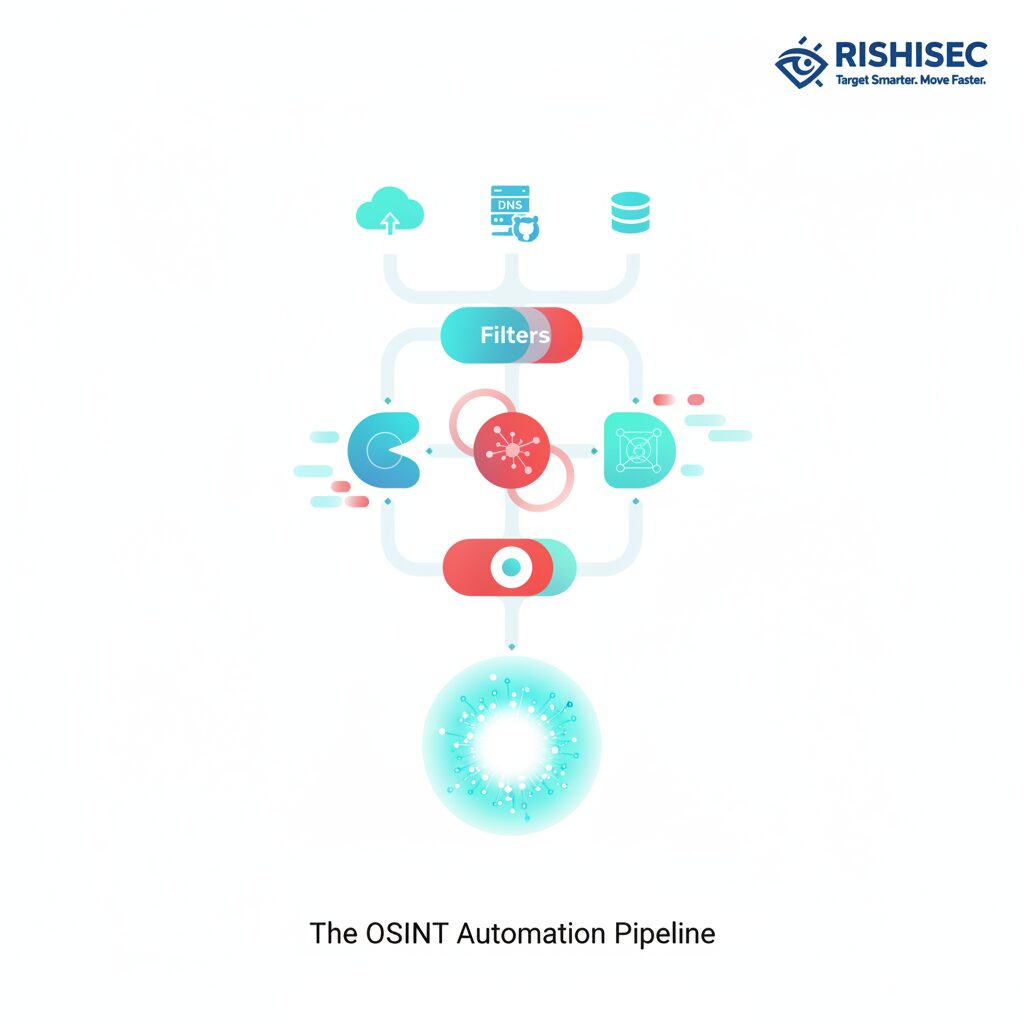
Web scraping automation requires more maintenance but remains necessary for valuable sources without API access. Social media platforms, technical forums, and corporate websites often contain critical intelligence unavailable through APIs. When building scrapers, prioritize maintainability over complexity. Simple scrapers using CSS selectors and XPath expressions are easier to debug and update when sites change. Additionally, implement robust error handling that logs failures without crashing the entire collection process.
AI-powered automation represents the cutting edge of penetration testing OSINT workflow optimization. Traditional automation excels at executing predefined tasks but struggles with analysis and decision-making. Machine learning models can classify findings by severity, predict likely vulnerabilities based on technology fingerprints, and suggest investigation paths that human testers might overlook. Platforms like Kindi demonstrate how AI-driven intelligence correlation accelerates penetration testing by automatically connecting related findings and highlighting high-value targets.
Data Management: From Raw Intelligence to Actionable Insights
Raw OSINT data has minimal value until transformed into structured, actionable intelligence. A list of 500 subdomains means nothing without context about which are internet-facing, which run vulnerable software, and which provide the best initial access vectors. Effective data management bridges this gap through systematic organization, enrichment, and prioritization.
Database selection significantly impacts workflow efficiency. Simple text files and spreadsheets suffice for small engagements but become unwieldy at scale. Relational databases like PostgreSQL provide structured storage with powerful querying capabilities. Graph databases excel at representing relationships between entities: employees connected to infrastructure, infrastructure connected to vulnerabilities, and vulnerabilities connected to attack techniques. Choose storage that matches your analytical needs.
Data enrichment adds context that amplifies intelligence value. When you discover a subdomain, immediately enrich it with HTTP responses, SSL certificate details, server headers, and technology fingerprints. When you identify an employee, enrich the record with their social media profiles, email patterns, and role information. Enrichment during collection prevents redundant lookups and ensures complete data for later analysis.
Tagging and categorization enable efficient filtering during analysis phases. Tag findings by confidence level to distinguish verified intelligence from assumptions. Categorize by attack relevance: immediate exploitation opportunities, infrastructure intelligence, and background context. Apply temporal tags indicating when intelligence was collected so you can prioritize fresh findings over stale data. Well-tagged intelligence transforms overwhelming datasets into manageable subsets focused on current objectives.
Collaboration Tools and Team Intelligence Sharing
Penetration testing increasingly involves team-based engagements where multiple consultants work in parallel. Solo testers might manually track their reconnaissance findings, but teams need shared intelligence repositories that prevent duplicate work and enable real-time collaboration. Without proper tooling, teams waste time rediscovering information, miss connections between different consultants’ findings, and struggle to maintain consistent documentation.
Centralized intelligence platforms solve the core collaboration challenge. Rather than each tester maintaining separate notes, all reconnaissance information is fed into a shared database accessible by the entire team. When one consultant discovers a credential leak in a GitHub repository, that finding immediately becomes visible to teammates investigating other attack vectors. Credential findings can then inform phishing campaigns, brute force attempts, or privilege escalation strategies across the engagement.

Real-time updates prevent the synchronization problems that plague team engagements. When testers work from local files or individual databases, findings become siloed until manual sharing occurs. Centralized platforms with live updates ensure every team member sees new intelligence immediately. This enables dynamic strategy adjustments as reconnaissance uncovers unexpected attack surfaces or defensive capabilities.
Access controls and audit logging maintain operational security during collaborative intelligence sharing. Not every team member needs access to every finding. Junior consultants might access sanitized intelligence while senior testers view raw data including potentially sensitive discoveries. Audit logs track who accessed what information and when, creating accountability and enabling post-engagement security reviews.
Documentation generation from shared intelligence repositories eliminates redundant reporting work. Rather than each tester writing separate sections and later reconciling inconsistencies, reporting tools can query the intelligence database to generate consistent findings documentation. This ensures technical accuracy, prevents contradictory statements, and dramatically reduces time spent on report writing.
Measuring and Optimizing Your OSINT Workflow Performance
You cannot optimize what you do not measure. Successful penetration testing OSINT workflow optimization requires quantitative metrics that reveal bottlenecks, inefficiencies, and opportunities for improvement. Without measurement, workflow changes become guesswork that may help, harm, or have no effect.
You cannot optimize what you do not measure. Successful penetration testing OSINT workflow optimization requires quantitative metrics that reveal bottlenecks, inefficiencies, and opportunities for improvement. Without measurement, workflow changes become guesswork that may help, harm, or have no effect.
Time-to-intelligence metrics quantify reconnaissance efficiency. How long does initial reconnaissance take from engagement kickoff to completing your intelligence baseline? Track this across engagements to identify trends. Decreasing time-to-intelligence indicates workflow improvements are working, while increasing times suggest new inefficiencies entering your process. Break down reconnaissance into phases like infrastructure enumeration, personnel mapping, and technology identification to pinpoint exactly where time gets consumed.
Coverage metrics ensure thoroughness despite optimization. Faster reconnaissance means nothing if you miss critical attack surfaces. Define coverage benchmarks: minimum subdomains discovered, employee profiles mapped, technology stack components identified. Compare your findings against industry standards or past engagements with similar target profiles. Consistent coverage despite reduced time proves optimization success rather than corner-cutting.
Automation effectiveness measures how much manual work gets eliminated. Calculate the percentage of intelligence collected through automated versus manual means. High-performing teams typically achieve 70-80% automated collection, reserving manual effort for specialized sources requiring human judgment. Track automation reliability through failure rates and required manual intervention frequency. Brittle automation that constantly breaks wastes more time than it saves.
Intelligence quality metrics differentiate useful findings from noise. Not all reconnaissance data carries equal value for penetration testing. Count how many findings translate into actionable test cases, vulnerability discoveries, or report findings. Low conversion rates suggest workflow inefficiencies in prioritization or analysis phases. Additionally, track false positive rates where intelligence appeared valuable but led nowhere during testing.
| Performance Metric | Target Benchmark | Optimization Signal |
|---|---|---|
| Time-to-Intelligence | Under 8 hours for initial baseline | Decreasing trend indicates workflow efficiency gains |
| Coverage Completeness | 90%+ of expected attack surface discovered | Maintaining coverage while reducing time proves true optimization |
| Automation Rate | 70-80% intelligence via automated collection | Increasing automation without quality loss drives efficiency |
| Actionable Finding Ratio | 30%+ reconnaissance leads to test cases | Higher ratios indicate better prioritization and analysis |
| Documentation Overhead | Under 15% of total engagement time | Reducing documentation time without sacrificing quality |
Common Workflow Optimization Mistakes to Avoid
Penetration testing teams often make predictable mistakes when optimizing OSINT workflows. Recognizing these pitfalls prevents wasted effort and helps maintain quality throughout optimization initiatives. The most common mistake involves over-automation of tasks better suited for human judgment. Not every reconnaissance activity benefits from automation, particularly those requiring contextual understanding or nuanced interpretation.
Tool hoarding represents another frequent optimization mistake. Consultants discover new reconnaissance tools and immediately incorporate them into workflows without evaluating whether they provide unique value. This creates tool sprawl where ten different utilities all enumerate subdomains slightly differently. Instead of adding tools indiscriminately, evaluate whether new capabilities truly enhance your intelligence collection or merely duplicate existing functionality.
Premature optimization wastes effort on minor inefficiencies while major bottlenecks persist. Before building complex automation or integrating specialized tools, identify your biggest time consumers through measurement. Perhaps manual data entry takes hours that simple scripting could eliminate. Maybe scattered documentation creates redundant work that centralized platforms would solve. Focus optimization efforts where they deliver maximum impact rather than perfecting minor processes.
Neglecting maintenance creates technical debt that eventually destroys workflow efficiency. Automated collection scripts break when APIs change. Documentation templates become outdated as reporting requirements evolve. Intelligence categorization schemes grow inconsistent as new finding types emerge. Schedule regular workflow reviews that update automation, refresh documentation, and incorporate lessons learned from recent engagements.
Advanced Integration: Connecting OSINT to Active Testing Phases
Truly optimized penetration testing workflows seamlessly bridge OSINT reconnaissance with active vulnerability testing and exploitation. Too often, testers treat reconnaissance as a completely separate phase that concludes before active testing begins. This artificial separation misses opportunities for continuous intelligence collection that informs testing strategies and validates exploitation success.
Intelligence-driven testing prioritizes efforts based on reconnaissance findings rather than generic vulnerability checklists. When OSINT reveals that a target heavily uses AWS infrastructure, prioritize cloud-specific testing techniques. When reconnaissance identifies specific software versions with known vulnerabilities, test those immediately rather than following predetermined testing sequences. This approach maximizes efficiency by focusing effort where success likelihood is highest.
Continuous reconnaissance throughout engagements catches infrastructure changes that impact testing strategy. Organizations deploy new systems, modify configurations, and adjust security controls constantly. OSINT workflows should run in background during active testing, alerting testers to relevant changes. Discovering a newly deployed subdomain or recently published security advisory mid-engagement can pivot testing directions toward higher-value targets.
Post-exploitation intelligence collection validates findings and informs reporting. After successfully compromising a system, use OSINT techniques to understand what data you accessed, which business functions you impacted, and how defenders might detect your activity. This context transforms technical findings into business-relevant insights that resonate with client stakeholders. Additionally, understanding how your activities appear from a defensive perspective helps clients improve their detection capabilities.
Building Your Optimized Workflow: Implementation Roadmap
Transforming inefficient manual processes into streamlined penetration testing OSINT workflows requires systematic implementation. Attempting wholesale replacement of existing processes creates disruption that reduces productivity before improvements materialize. Instead, follow a phased approach that delivers incremental benefits while minimizing operational risk.
Phase one focuses on documentation and standardization. Before optimizing workflows, document your current reconnaissance processes completely. What sources do you check? Which tools do you use? How do you organize findings? This baseline reveals inefficiencies and provides a benchmark for measuring improvement. Simultaneously, standardize processes across team members so everyone follows consistent methodologies.
Phase two introduces basic automation for the highest-impact, lowest-risk tasks. Begin with subdomain enumeration, DNS intelligence, and certificate transparency searches because these have reliable tools, stable data sources, and clear value. Build simple automation scripts that query multiple sources in parallel and output consolidated results. This phase typically delivers 30-40% time savings with minimal implementation risk.
Phase three implements centralized intelligence platforms that enable collaboration and eliminate data silos. Migrate from scattered text files and spreadsheets to databases or specialized OSINT platforms. This transition requires initial time investment but pays dividends through improved team coordination, eliminated duplicate work, and streamlined reporting. Platforms like Kindi accelerate this phase by providing pre-built intelligence infrastructure designed specifically for security teams.
Phase four incorporates advanced automation and AI-powered analysis that handles complex correlation and prioritization. Machine learning models can predict likely vulnerabilities based on technology fingerprints, identify high-value targets from reconnaissance data, and suggest testing strategies tailored to target characteristics. This phase represents the cutting edge of penetration testing OSINT workflow optimization and delivers the most dramatic efficiency gains.
Future-Proofing Your OSINT Workflows
Technology evolution constantly threatens to obsolete carefully optimized workflows. Cloud platforms introduce new intelligence sources and require new collection techniques. AI capabilities enable more sophisticated automation but also power defensive systems that detect reconnaissance. Privacy regulations restrict certain collection methods while creating new opportunities for compliance-focused intelligence gathering. Future-proof workflows adapt to these changes rather than requiring complete rebuilds.
Modular workflow architectures enable component-level updates without disrupting entire processes. Design collection, processing, analysis, and reporting as separate modules with defined interfaces. When new intelligence sources emerge, add new collection modules without modifying existing components. When analysis techniques improve, upgrade analysis modules while preserving proven collection and reporting functionality.
Continuous learning ensures workflows incorporate emerging techniques and tools. Schedule regular workflow reviews where team members share discoveries, evaluate new tools, and discuss optimization opportunities. Monitor cybersecurity communities, attend conferences, and engage with peers to identify trends before they become mainstream. Early adoption of valuable techniques provides competitive advantages over consultants using outdated methodologies.
Flexibility in tool selection prevents vendor lock-in that restricts future optimization. Workflows built around single proprietary tools become hostage to vendor roadmaps and pricing decisions. Prefer open standards, documented APIs, and modular architectures that enable tool substitution. If your current subdomain enumeration tool becomes unmaintained, you should be able to swap in alternatives without rewriting your entire workflow.
Practical Workflow Optimization Tips
- Start each engagement with a reconnaissance checklist customized for the target industry and technology stack
- Automate routine data collection tasks but preserve human judgment for contextual analysis and prioritization
- Use centralized intelligence platforms to eliminate scattered documentation and enable real-time team collaboration
- Implement continuous reconnaissance that runs in background throughout engagements, not just during initial phases
- Tag and categorize findings immediately during collection to prevent analysis bottlenecks later
- Build reusable reporting templates that query intelligence databases to generate consistent documentation
- Schedule regular workflow retrospectives after engagements to identify inefficiencies and capture lessons learned
- Measure key performance indicators like time-to-intelligence and coverage completeness to track optimization progress
- Maintain runbooks documenting your reconnaissance processes so new team members can quickly become productive
- Integrate OSINT findings directly into testing tools and vulnerability scanners to enable intelligence-driven prioritization
FAQ
What is the biggest time waster in penetration testing OSINT workflows?
Manual data entry and reformatting between tools consumes the most time in typical workflows. Testers query one tool, copy results into a text file, run another tool, manually correlate findings, and repeat this process dozens of times. Eliminating these manual handoffs through automation or integrated platforms typically saves 40-60% of reconnaissance time without reducing coverage quality.
How much should cybersecurity consultants invest in OSINT workflow optimization?
Initial workflow optimization requires 40-80 hours of focused effort to document processes, implement basic automation, and establish centralized intelligence management. However, this investment typically pays back within 5-10 engagements through reduced reconnaissance time. Ongoing optimization requires approximately 10-15% of time allocated to maintaining automation, updating processes, and incorporating new techniques. Teams that skip optimization waste far more time through inefficiency than optimization requires.
Can small consulting firms benefit from advanced OSINT automation platforms?
Yes, small firms often benefit more from automation platforms than large organizations. Solo consultants and small teams lack the resources to build custom automation infrastructure, making commercial platforms particularly valuable. Additionally, smaller firms handle fewer simultaneous engagements, meaning automation benefits compound more quickly. Platforms that handle intelligence collection, correlation, and collaboration let small teams compete with larger competitors who have dedicated tool development resources.
How do you balance speed optimization with thoroughness in reconnaissance?
Effective balance comes from standardizing comprehensive collection while accelerating execution through automation. Define minimum coverage requirements that every engagement must meet regardless of time pressure. Then optimize how quickly you achieve that coverage through parallel collection, automated processing, and efficient prioritization. Speed optimization should reduce time-to-baseline without lowering the baseline itself. Measure both speed and coverage metrics to ensure optimization does not compromise quality.
What makes penetration testing OSINT workflows different from other intelligence operations?
Penetration testing OSINT requires actionable technical intelligence that directly informs vulnerability testing and exploitation. Unlike strategic intelligence operations focused on trends and long-term patterns, penetration testing needs immediate tactical details like specific software versions, network configurations, and access vectors. Additionally, penetration testing workflows must integrate reconnaissance with active testing phases rather than treating intelligence as a standalone deliverable. This requires different prioritization, faster turnaround times, and tighter coupling between intelligence and action.
Ready to transform your penetration testing efficiency? Explore our OSINT courses for hands-on training in workflow optimization and advanced reconnaissance techniques. Want to eliminate manual OSINT bottlenecks? Try Kindi and experience AI-powered intelligence automation built specifically for security professionals.

